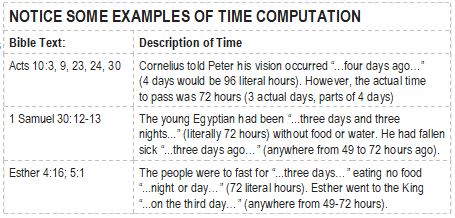by William J. Stewart
A careful analysis of the four accounts of Jesus’ death, burial and resurrection enables us to know the days on which these events occurred, and to see that indeed, Jesus was in the tomb for “…three days and three nights…” (Matthew 12:40) as He foretold. Upon looking at the texts, we can clearly see a succession of five consecutive days, the first of these being Nisan 12 of the Jewish calendar, and the last being the “…first day of the week…” or as is more commonly called today, Sunday.
The Jewish Week VS The Roman Week

Note, the Jewish day is calculated from sunset to sunset (approx. 6 p.m. to 6 a.m.), whereas the Roman day is calculated from midnight to midnight.
 The time spent by Jesus in the tomb is described several different ways (three days and three nights, on the third day, in three days, after three days, until the third day, three days later, the third day, see Matthew 12:40; 16:21; 17:23; 26:61, 63, 64; 27:40, 64; Mark 9:31; 10:34; Luke 18:33; 24:21). These are all used interchangeably. The question is whether it demands a literal 72 hours or merely parts of three days and three nights.
The time spent by Jesus in the tomb is described several different ways (three days and three nights, on the third day, in three days, after three days, until the third day, three days later, the third day, see Matthew 12:40; 16:21; 17:23; 26:61, 63, 64; 27:40, 64; Mark 9:31; 10:34; Luke 18:33; 24:21). These are all used interchangeably. The question is whether it demands a literal 72 hours or merely parts of three days and three nights.
Now, let’s look at the 5 consecutive days the Scriptures show us, beginning at Nisan 12, and ending with the first day of the week. We will use Mark’s gospel as our base text, but notice how the other gospels supply substantial support to the chronology.
The details above are summarized in the diagram below. Did Jesus have to be in the tomb a literal 72 hours to fulfill the “…three days and three nights…”? As noted, part of a day can be counted for the whole. If Jesus was in the tomb for part of three days, then the Scripture is fulfilled. Note, whether we are talking about Jewish days (sunset to sunset) or Roman days (midnight to midnight), our Lord was in the tomb “…until the third day.”




